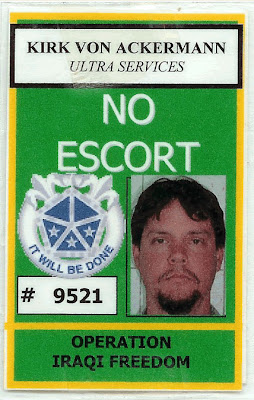I wonder if this will effect the NSA appeal?
Saturday, March 28, 2009
Thursday, March 26, 2009
Contractor Deployment Guide
I was looking for more background information on general identification requirements for contractors working overseas when I stumbled upon this Pamphlet. Fascinating reading. As far as I can tell, this is the most recent version. It really is a must read for anyone going to work overseas.
Ed. note for June 14, 2010: please use this new link DA PAM 715-16
Contractor Deployment Guide
Pamphlet 715–16
Department of the Army
27 February 1998
DA PAM 715–16The Pamphlet includes a short section on Hostages (see page 6), which contains some information that I don't recall reading before.
Contractor Deployment Guide
This new Department of the Army pamphlet provides procedures for contractor operations within the Department of the Army.
Chapter 11As far as identification...no surprises. Seems basic. But what exists on paper and what's done in reality are two different things. So, the question that really needs answering is: what identification were Ultra Services personnel expected to carry back in Iraq in 2003?
11–1. Hostage aid
a. Hostages
When and where the Secretary of State, in consultation with the Secretary of Labor, declares that U.S. citizens or resident aliens of the United States rendering service overseas have been placed in a “captive” status as a result of a “hostile action” against the U.S. government, a wide range of benefits accrue to that person and that
person’s dependents. For example, captives can continue to receive their full pay. Captives can claim some, but not all, of the benefits of the Soldiers’ and Sailors’ Civil Relief Act. A person designated as a captive or his/her family members are eligible for physical and mental health care benefits at U.S. government expense. A spouse
or unmarried dependent of a designated captive is eligible for certain education benefits. If a designated captive ultimately dies from hostile action caused by his/her relationship to the U.S. government, the Secretary of State may provide death benefits to the captive’s survivors.
b. Any person possibly affected (e.g., family members and dependents) may petition the Secretary of State to make the declaration of coverage. Pursuing benefits and remedies under these laws is up to the contractor employee and/or the employee’s family members, dependents or employer.
Identification mentioned in the Contractor Deployment Guide:
PassportNot mentioned:
Visas - as needed
Invitational Travel Orders
Uniformed Services Identifications and Privilege Card (DD Form 1173)
Geneva Conventions Identity Card (DD Form 489)
Personal Identification ('dog tags')
Local In-theater Identification (Baghdad International Airport, etc)
Authorization to carry a weapon (from Theater Commander or State Department)
Record of Emergency Data Card (DD Form 93)
Company Id
Drivers license
Record of Immunizations
Medical information ('medical tags')
Common Access Card (DD Form 1172-2)Looking over the list above, what exactly was the green id card issued to Kirk von Ackermann featured in the Rolling Stone article? Was it still valid? And what happened to all of the other identification he should have been carrying?
Always questions.
Related
Base Access
March 20, 2009
Friday, March 20, 2009
Base Access
Color me completely baffled today. An article via Ms Sparky...
By David Murdock, The Huffington Post, March 19, 2009
In what appears to be a stunning lack of due diligence, the Pentagon has allowed private contractors to grant civilians access to military bases, including in highly sensitive areas like Iraq and Afghanistan, without evidence of appropriate background checks.Identification
The revelations were detailed in a recent report that the Acting Inspector General of the Department Defense, Gordon S. Heddell, delivered to the House Appropriations Defense Subcommittee. The report describes how, since 2002, Common Access Cards -- the IDs that both troops and civilians use to pass through military checkpoints around the world - may have been granted to nearly 40,000 civilians without proper vetting.
Some basic information on Common Access Cards can be found here and here. Suffice it to say, access cards are not new. As time marches on and technology improves, more security features are added to the id's. Methods of displaying identification are also not new. When on base, contractors are generally supposed to carry identification at all times, usually in one of those black neck pouches that are commonly found at an office supply store.
Security
Anyone who reads this blog knows I have a serious problem with the assumption Kirk von Ackermann disappeared from where his vehicle was found. His behavior that day was so out of character, so irrational, that investigators actually floated the idea he staged his own disappearance.* But there is a much more rational explanation for the sudden and swift departure of basic common sense. Simply put, von Ackermann was abducted and killed elsewhere - likely an American base - and the most likely candidate is Camp Anaconda. All of this, of course, means an imposter placed the call to the Iraqi employee.
Now, on a fairly regular basis I try to tear down and poke holes into the above theory because quite frankly, I don't want to be right. Two of the easy to spot weak points have always been the id badge and base access - both of which tie into getting on to and off of a base.
*Mystery surrounds US businessman missing in Iraq's 'Sunni triangle'
By Colin Freeman, UK Telegraph, November 9, 2003
The strange circumstances of the case have prevented investigators from ruling out the possibility that he has tried to fake his own disappearance. In particular, they are thought to be puzzled as to why he chose to drive alone that day, rather than taking an Iraqi colleague as he normally did.
Tuesday, March 03, 2009
Annual Longshore Conference
 Photo Source U.S. Navy's Military Sealift Command
Photo Source U.S. Navy's Military Sealift Command
The Annual Longshore Conference is March 19 - 20, 2009 in New Orleans, Louisiana. I attended the previous conference organized by Loyola University College of Law and the U.S. Department of Labor in the fall of 2008 in Washington D.C. and found it very informative. Pretty much everyone who knew anything about the Defense Base Act was there.
From the registration brochure:
This year’s program will address several timely topics of importance to any workers’ compensation practitioner.The Defense Base Act/War Hazards Compensation Act Handbook is on sale through Loyola College of Law for $60. Call (504) 861-5441 or Toll Free at (866) 250-8617 to order. For more information, email clelaw@loyno.edu
We will examine issues of competing jurisdiction. Despite decades of litigation seeking clarity in competing jurisdictional schemes, significant problems remain in navigating the myriad compensation programs that exist in the maritime field. Recent amendments to the Americans With Disabilities Act will impact return to work issues in workers’ compensation claims. Medicare Set-Asides continue to be important in settlements of longshore claims, and recent changes to the regulations and procedures for MSA will be explained.
We will also address various practice issues, such as trying claims before the Office of Administrative Law Judges, posthearing proceedings, and attorney fee claims. We will have medical experts address the expanding field of chronic pain conditions, and the diagnosis and treatment of these disorders. With the War on Terror continuing in both Iraq and Afghanistan, we will explore the Defense Base Act and War Hazards Compensation Act, as these remain important extensions of the [Longshore and Harbor Workers' Compensation Act] LHWCA.
For anyone with an interest in the Defense Base Act and/or issues facing American contractors working overseas, absolutely buy a copy of the DBA/WHCA Handbook. Most of the chapters were written by lawyers and judges whose careers are narrowly focused in DBA law.
Additional Reading
Defense Base Act Practice: We're Not in Kansas Anymore
By Roger A. Levy, Editor of the DBA/WHCA Handbook, Lexis/Nexis, August 19, 2008
U.S. Department of Labor
The Longshore and Harbor Workers’ Compensation Act (LHWCA) webpage





